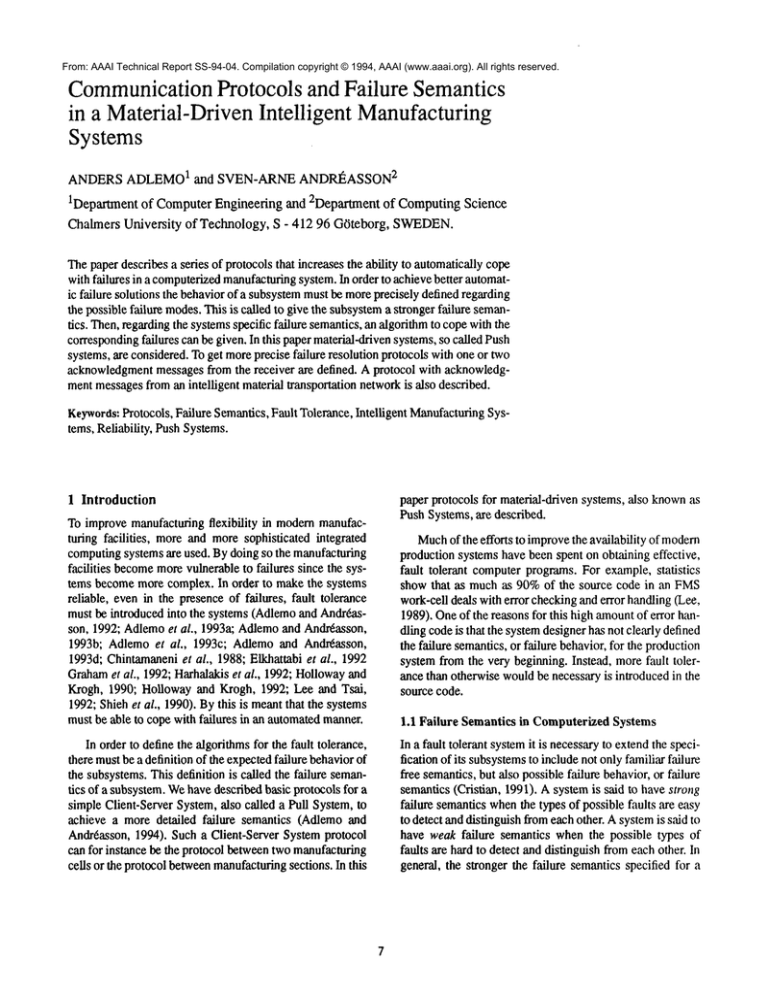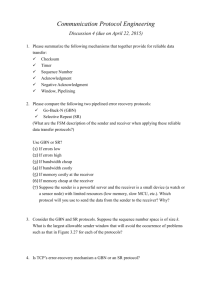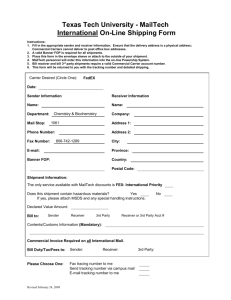
From: AAAI Technical Report SS-94-04. Compilation copyright © 1994, AAAI (www.aaai.org). All rights reserved.
Communication
Protocols and Failure Semantics
in a Material-DrivenIntelligent Manufacturing
Systems
ANDERS ADLEMO1 2and
SVEN-ARNE ANDRI~ASSON
1Department of Computer Engineering and 2Department of Computing Science
Chalmers University
of Technology, S - 412 96 G0teborg, SWEDEN.
The paper describes a series of protocols that increases the ability to automatically cope
with failures in a computerizedmanufacturingsystem. In order to achieve better automatic failure solutions the behavior of a subsystemmust be moreprecisely defined regarding
the possible failure modes.This is called to give the subsystema stronger failure semantics. Then,regarding the systemsspecific failure semantics, an algorithmto cope with the
correspondingfailures can be given. In this paper material-driven systems, so called Push
systems, are considered. To get moreprecise failure resolution protocols with one or two
acknowledgmentmessagesfrom the receiver are defined. A protocol with acknowledgmentmessagesfrom an intelligent material transportation networkis also described.
Keyworas:Protocols, Failure Semantics, Fault Tolerance, Intelligent ManufacturingSystems, Reliability, Push Systems.
1 Introduction
To improve manufacturing flexibility in modernmanufacturing facilities, more and more sophisticated integrated
computingsystems are used. By doing so the manufacturing
facilities becomemorevulnerable to failures since the systems becomemore complex. In order to make the systems
reliable, even in the presence of failures, fault tolerance
must be introduced into the systems (Adlemoand Andrtasson, 1992; Adlemoet al., 1993a; Adlemoand Andrtasson,
1993b; Adlemo et al., 1993c; Adlemoand Andrtasson,
1993d; Chintamaneniet al., 1988; Elkhattabi et al., 1992
Grahamet al., 1992; Harhalakis et al., 1992; Hollowayand
Krogh, 1990; Holloway and Krogh, 1992; Lee and Tsai,
1992; Shieh et al., 1990). Bythis is meantthat the systems
must be able to cope with failures in an automatedmanner.
In order to define the algorithmsfor the fault tolerance,
there mustbe a definition of the expectedfailure behaviorof
the subsystems.This definition is called the failure semantics of a subsystem.Wehave described basic protocols for a
simple Client-Server System, also called a Pull System, to
achieve a more detailed failure semantics (Adlemo and
Andrtasson, 1994). Such a Client-Server System protocol
can for instance be the protocol betweentwo manufacturing
cells or the protocol betweenmanufacturingsections. In this
paper protocols for material-driven systems, also knownas
Push Systems, are described.
Muchof the efforts to improvethe availability of modern
production systems have been spent on obtaining effective,
fault tolerant computerprograms. For example, statistics
show that as muchas 90%of the source code in ,an FMS
work-cell deals with error checkingand error handling (Lee,
1989). Oneof the reasons for this high mnountof error handling codeis that the systemdesigner has not clearly defined
the failure semantics, or failure behavior, for the production
system from the very beginning. Instead, morefault tolerance than otherwise wouldbe necessary is introduced in the
source code.
1.1 Failure Semantics in ComputerizedSystems
In a fault tolerant systemit is necessaryto extend the specification of its subsystemsto include not only familiar failure
free semantics, but also possible failure behavior, or failure
semantics (Cristian, 1991). A systemis said to have strong
failure semantics whenthe types of possible faults ,are easy
to detect and distinguish fromeach other. A systemis said to
have weak failure semantics when the possible types of
faults are hard to detect and distinguish from each other. In
general, the stronger the failure semantics specified for a
system,the moreexpensiveit is to build a systemthat implementsthe semantics. However,a system with stronger failure semanticsleads to simpler and moreefficient fault tolerant mechanisms
for higher systemlevels. The table belowillustrates the advantages and disadvantages of strong and
weakfailure semantics.
Failure
semantics
Advantages
Disadvantages
S~ong
Cheap error handling
Expensivesemantics
implementation
Weak
Cheapsemantics
implementation
Expensiveerror
handling
In (Cristian, 1991) failure semanticsfor the time aspect
of a client/server responseis defined. This leads to four types
of failure semantics: crash failure semantics, omissionfailure semantics, timing failure semanticsand arbitrary failure
semantics.
2 A Push Manufacturing
start with a very simple system without acknowledgment
messages, then continues with a system with one acknowledgment message per request and a system with two acknowledgmentmessages per request.
The failure effects and failure semantics is given from
the senders point of view. The reason for defining a failure
semantics is to give the sender a foundation for howto cope
with a given failure.
The following failures might occur:
- there might be a material transportation networkfailure,
the productmightbe sent to a receiver with a full input buffer,
the product might be sent to a non-functioning receiver,
the receiver mightfail during the continuingtask.
2.1.1 System without acknowledc, ment messages
System
The classifications of failure semantics madein (Cristian,
1991) and (Adlemoand Andr6asson,1994) are so called client-server systems or pull systems (Sartori, 1988). This
meansthat a client makesa request to a server and waits for
an answer. The behavior of, and response from, the server
undercertain faulty situations defines the failure semantics
exhibited by the server, that is, in turn, perceivedby the client. This paper, however, addresses manufacturing systems
that are pure push systems. A simple manufacturing system
that is built as a pure push systemwith manufacturingcells
and AGVs
is illustrated in figure 1.
Data network
R
Receiver
........... t:,. Product
Whenthere are no acknowledgmentmessages, it is assumed
that the product will arrive to the correct receiver and that
there are no full buffers in the system. The systemprotocol
is describedin figure 2.
’"’..................
.....................
R
l
R
Receiver
S
Sender
Psond
S sends the productP
Figure2: Material-Driven
interaction without
acknowledgments
Material transportation network
Figure 1: A manufacturingsystem
(pushsystem).
2.1 Simple Push System
This section presents protocols for a simple Material-Driven
Push Systemwherea sender 9 sends a product P to a receiver R using a material transportation networkMTN
after each
completed task at the sender S. The protocol descriptions
Consequently,it is impossiblefor the sender to take ,appropriate actions due to a failure whenusing this simple protocol since the sender has no wayto find out what happens.
2.1.2 System with one acknowledgment message Pqr
request
To makeit possible to allow for an error recovery, an acknowledgmentmessage is added to the protocol. Whenthe
receiver R gets the product P, it sends an acknowledgment
message,ACKr,to the sender S. This protocol is described in
figure 3.
L,tll ....................................................
-.....................
.,,,..................
R
I
ACKr
/
-1
S
ACKc
R
i
I
ACKr
~
S
~L
R
Receiver
S
Sender
R
Receiver
Psend
S sends the product P
S
Sender
ACKr
Reception acknowledgment
Psend
S sends the productP
ACKe
Completion acknowledgment
ACKr
Reception acknowledgment
Figure4: Material-Driven
interaction with two
acknowledgment
messages.
Figure3: Material-Driven
interaction withone
acknowledgment
message.
Thefollowingtable gives the different results that can be
obtained from one single product sending, Psond.
If there is no ACKrmessagethere is a failure. There
might be a material transportation networkfailure, a data
networkfailure or the receiver is not working.The different
failure behavior, as seen fromthe sender, is given in the followingtable.
Psend
Psend
ACKr
ACKc
no ACKc
no ACKr
ACKc
no ACKc
ACKr
no ACKr
2.1.3 System with two acknowledgmentmes~ees per task
To further improvethe efficiency of error recovery another
acknowledgmentmessage is added to the protocol. When
the correspondingproduct is treated and shipped to the next
server, another acknowledgment
message, ACKe,is returned
to the sender S. In this waythe original sendingserver S can
check its following server R. This scenario is described in
figure 4.
The arrival of an ACKrmessagepresents a possibility to
exclude material networkfailures. If there is no ACKc
message after the arrival of the corresponding ACKrmessage
there might be a server failure. However,there might occur
a data network failure during the second acknowledgment
message.
Whendealing with different types of failures (one per
each row in the table except the first row), all or a part of
these can be taken care of. The types of failures that are taken care of gives the failure semantics expected fromthe receiver R. Other failures will lead to a system crash, since
they are not taken care of.
2.2 Push Systemwith "intelligent" material transport
system
In order to give a moredetailed failure semanticsfor the system as seen by the sender, an acknowledgment message
from the material transport networkis introduced. This implies that there is a material transport networkthat is connected to the data network(at certain times or always).
messageACKd
is sent to the sender whenthe product is delivered to the receiver. In this waythere is a possibility to
distinguish betweenmaterial transportation networkfailure
and receiving server failure (figure 5).
.
it|| ....................................................
Psend
(~
ACKd
ACKr
.
ACKc
.
R
Receiver
S
Sender
MTN
MaterialTransportationNetwork
Psend
S sendsthe productP
ACKd
Delivery acknowledgment
ACKr
Reception acknowledgment
ACKc
Completionacknowledgment
.
Figure5: Material-Driven
interaction withmaterial
transport networkacknowledgment
messages.
.
Thefollowingtable gives the different results that can be
obtained from one single product sending, Psend.
Psend
ACKd
ACKr
ACKc
The product is delivered but there is no response from
the receiver. Either the receiver is not working,or the
data network has had a longer breakdown.
There is no delivery acknowledgement
from the material
transportation networkbut instead a reception acknowledgementfrom the receiver. In this case there has been
communicationproblems with the data network from the
material transportation network.
There is no delivery acknowledgement
from the material
transportation networkbut instead a reception acknowledgement from the receiver. Then no completion acknowledgement
is received from the receiver. This indicates that there is problemsin the data network. However, there might be a combinationof a single data network
failure and receiver service failure.
There is no delivery acknowledgement
from the material
transportation network and no reception acknowledgementfrom the receiver. However,later a completion,acknowledgement
is received from the receiver. This indicates that there has beena longer failure in the data network.
1
8. Noresponse at all. Either a material transportation networkfailure or a data network breakdown.
no ACKc
.
no ACKr
The product is delivered but there is no reception
acknowledgementfrom the receiver. Howeverthere is
later a completion acknowledgementfrom the receiver.
This implies that there was a shorter failure in the data
network.
ACKc
2.2.1 Usin~ a ne~,ative acknowledemcntm¢~sagefrom the
material transnortation network
.
no ACKc
.
no ACKd
ACKr
ACKc
To get a possibility to distinguish material transportation
networkfailure fromthe case that the buffer is full at the receiver, a Buffer Full at Receiver Messagecan be introduced.
.
no ACKe
.
no ACKr
ACKc
.
no ACKc
3 Conclusions
.
The different failure modesare described below:
1. This case describes the normal behaviour when everything is workingas it should.
.
In this case there is both a delivery acknowledgement
from the material transport networkand a reception acknowledgementfrom the receiver. But there is no completion acknowledgementfrom the receiver. This case
implies a server failure by the receiver. However,there
might have occurred a data networkfailure instead.
10
In this paper was described different protocols that give different failure semantics, or failure behavior, for computerized manufacturing systems. By using one or two acknowledgment messages from the sender and zero or one ,acknowledgmentmessagefrom the material transport network
the failure semantics can be given more precisely, which
will makeit easier to take measuresto copewith failures. In
this waythe systems can be mademore reliable.
The protocols were given for a material-driven, system,
a so called push system. For one of the protocols the failure
modesand their causes were given.
4 References
Adlemo,A., and S.-A. AndrOsson(1992). Modelsfor fault
tolerance in manufacturingsystems. Journal of Intelligent Manufacturing,3, pp. 1-10.
Adlemo,A., S.-A. Andr6asson, and M. I. Johansson
(1993a). Fault tolerance strategies in an existing FMS
installation. Control EngineeringPractice, 1, pp. 127134.
Adlemo,A., and S.-A. Andr6asson(1993b). Fault tolerance
in partitioned manufacturingnetworks. Journal of Systems Integration, 3, pp. 63-84.
Adlemo,A., S.-A. Andr6asson, and M. I. Johansson
(1993c). Information Accessibility and Reliability Improvement in an Automated Kitting System. Proceedings of the 12th WormCongress of the International
Federation of Automatic Control, IFAC’93, Sydney,
Australia, vol. 3, pp. 99 - 106.
Adlemo,A., and S.-A. Andr6asson(1993d). Failure semantics in intelligent manufacturingsystems. Proceedingsof
the 1993 IEEE International Conference on Robotics
and Automation.Atlanta, U.S.A., vol. 2, pp. 166 - 173.
Adlemo,A., and S.-A. Andr6asson(1994). Communication
Protocols and Failure Semanticsin Intelligent Manufacturing Systems. Will appear in Proceedingsof the 1994
IEEE International Conference on Robotics and Automation. San Diego, U.S.A. (May 1994).
Chintamaneni,P. R., P. Jalote, Y.-B. Shieh, and S. K. Tripathi (1988). On fault tolerance in manufacturing systems. IEEENetwork, 2, pp. 32-39.
Cristian, F. (1991). UnderstandingFault Tolerant Distributed Systems. Communications
of the ACM,vol. 34, no. 2,
pp. 56 - 78.
Elkhattabi, S., D. Corbeeand, J. C. Gentina(1992). Integration of Dependability in the Conception of FMS.Preprints of the 7th IFAC/IFIP/IFORS/IMACS/ISPE
Symposium on Information Control Problems in Manufacturing Technology, INCOM’92,Toronto, Canada, pp.
249 - 254
Graham,J. H., J. Guan, and S. M. Alexander (1992). A hybrid CIMdiagnosis system with learning capabilities.
Proceedings of the 3rd International Conference on
ComputerIntegrated Manufacturing. Troy, U.S.A. pp.
308-314.
Harhalakis, G., C. P. Lin, R. Nagi, and J. M. Proth (1992).
Hierarchical decision making in computer integrated
manufacturing systems. Proceedingsof the 3rd International Conference on ComputerIntegrated Manufacturing. Troy, U.S.A. pp. 15-24.
Holloway, L. E., and B. H. Krogh(1990). Fault detection
and diagnosis in manufacturing systems: a behavioral
model approach. Proceedings of the 2nd International
Conference on Computer Integrated Manufacturing.
Troy, U.S.A. pp. 252-259.
Holloway,L. E., and B. H. Krogh(1992). On-line fault detection via trajectory encoding. Preprints of the 7th
IFAC/IFIP/IFORS/IMACS/ISPE Symposium on lnfor-
11
mation Control Problems in Manufacturing Technology,
INCOM’92.Toronto, Canada. pp. 643- 648.
Lee, J., and J. Tsai (1992). Fault detection in intelligent material handing. Proceedings of the 3rd International
Conference on Computer Integrated Manufacturing.
Troy, U.S.A. pp. 298-307.
Lee, M. (1989). Intelligent Robotics. Halsted, NewYork,
USA.
Sartod, L. G. (1988). ManufacturingInformation Systems.
Addison-Wesley Publishers Ltd., Wokingham,UK.
Shieh, Y.-B., D. Ghosal, P. R. Chintamaneniand S. K. Tripathi (1990). Modelingof Hierarchical Distributed Systems with Fault Tolerance. IEEE Transactions on SoftwareEngineering,vol. 16, no. 4, pp. 444 - 457.








